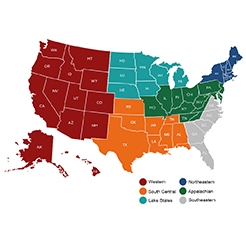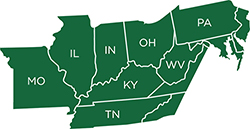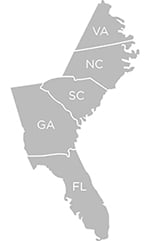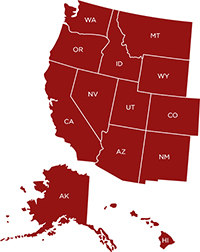FRA Region Reports

Members active in FRA’s six Regions develop technical and policy programs that speak to their own needs. Regional leadership identifies emerging supply chain challenges, convenes to identify solutions or educational programs, and refers issues that stretch beyond regional boundaries—such as federal transportation rules or employment law—to FRA’s national governance, to bring broader resources or influence to addressing them—whether in national policy advocacy or in adopting innovations.
In return, FRA’s national organization draws on the highly developed regional grassroots capacity to leverage our access with policymakers.
Here is a roundup of issues and trends impacting FRA’s respective regions in 2020, topics that were addressed, and short summaries of what is on the horizon:
Appalachian Region

Issues & Trends
COVID-19
The COVID-19 virus outbreak of early 2020 disrupted the production at wood and paper manufacturing facilities for several months in the year, as mills, loggers, and truckers adjusted to outbreaks and new work restrictions or procedural changes. The ripples from this were felt throughout the entire wood fiber supply chain.
Economic Outlook
Hardwood sawtimber and lumber is the dominant wood products industry and the driving force behind the Appalachian Region’s (AR) hardwood market. Overseas demand for American hardwood logs and lumber declined significantly for much of 2020 due to COVID-19 and retaliatory tariffs from China. Additionally, the recent permanent closures of pulpwood-using mills in Kingsport, TN, Roaring River, NC, and Roaring Spring, PA have had strong negative impacts on hardwood pulpwood usage. This demand had already been on a long, slow path of decline in the AR as a few other pulp mills ceased operations in previous years. The lower demand for hardwood pulpwood is impacting the ability of forest landowners in some localities to improve the health and quality of their timber, as loggers may not be able to cut the pulpwood in tracts.
Markets Improved
Beginning in late 2020 and continuing into 2021, the hardwood lumber and sawtimber market has been improving. It remains to be seen whether there will be enough log trucking capacity to meet this increasing demand for wood; trucking is still suffering from driver shortages and high insurance rates.
FRA Activity
The Appalachian Region Spring Policy Committee
April 1, 2020 – The AR Spring Policy Committee Virtual Meeting included presentations from two Virginia Tech forestry professors who provided a summary of the forestry school’s undergraduate program as well as current and past research projects of interest to the forest products industry.
Webinar
September 22, 2020 – The Appalachian Region hosted a webinar on Appalachian Region (AR) Hardwood Timber/Lumber Supply & Demand Overview, and Cable-Assist/Tethered Logging Operation. This webinar featured speakers that presented the following: a hardwood market overview focused primarily on FRA’s AR; and a video and demonstration of an innovative cable-assist and tethered logging operation on Lyme Timber property in the mountains of southern West Virginia.
On the Horizon
Spring 2021 (date TBA) – FRA’s AR will be hosting a webinar and Steering Committee Meeting this Spring in April. Please be on the look out for more information.
Fall 2021 (date TBA) – AR Fall Meeting and forestry field trip near Beckley, WV.
Lake States Region

Issues & Trends
Mill Closures
The Lakes States Region (LSR) was hit hard in 2020 as several mills curtailed production or announced closures. As a result, demand for wood fiber has been significantly reduced. The impacts on logging business of these curtailments and closures may be delayed as many businesses had received grants from the Paycheck Protection Program. This has allowed businesses to retain employees and continue operations.
National Forests Continue to Increase Timber Sold Volumes
The FRA administered Lake States Federal Timber Purchasers Committee met with the region’s national forests supervisors, the Region 9 Forester, and regional staff in October. During the meeting, the Forest Service reported an increase of 13 percent in the timber volume sold year-over-year FY2019 vs. FY2020. In the last three years, the LSR national forests have increased timber sold volume by nearly 30 percent. The timber target for FY2021 is 493 million board feet, which, if met, would be an increase of 60 MMBF, nearly a 13 percent increase when compared to FY2020.
FRA Activity
Lake State’s Region Outstanding Logger Recognized
Fjeran Forest Products from Two Harbors, MN, was recognized as FRA’s LSR Outstanding Logger for 2020. Chad Morgan, FRA LSR Policy Committee Chair, recognized Blake Fjeran and his family during the Region’s Annual Meeting and virtually presented them a plaque from FRA and a gift certificate for a chainsaw and a cash award of $250 compliments of STIHL. Fjeran Forest Products will now compete for the FRA National Logger of the Year recognition.
Lake States Region Bat Habitat Conservation Plan
FRA led the industry’s efforts to coordinate comments on the final chapters of the Lake States Region Bat Habitat Conservation Plan (HCP). A response from the region’s Departments of Natural Resources was received in October. The draft HCP will be submitted to the U.S. Fish and Wildlife Service for review and publication in the Federal Register, which will begin a public comment period. We anticipate the HCP plan to be completed in 2021.
Wisconsin and Minnesota Log Truck Research
FRA partnered with the National Timber Harvesting and Transportation Safety Foundation (THATS), Great Lakes Timber Professionals Association (GLTPA), Forest Industry Safety Training Alliance (FISTA), and the University of Minnesota on a study to analyze data to explore whether allowing state-legal log trucks on interstate highways will simultaneously increase both safety and efficiency of log truck transportation. FRA’s goal is to use the findings of the research to advance the Safe Routes Act. The researchers of this project are looking for participants who transport raw forest products. If you want to participate in the study, please contact Professor Charlie Blinn at [email protected].
On the Horizon
Fall 2021 (Date TBD) – FRA Lake States Region Fall Meeting – depending on when COVID-19-related concerns abate.
Northeastern Region

Issues & Trends
Attracting New Wood Using Industries
Efforts in Maine and across the region have focused on attracting new wood-using industries to the Northeast, particularly those using low-grade wood. To date, some smaller projects have broken ground or been announced, but there remains significant opportunity for new forest manufacturing in all the Northeastern states.
Rapid Changes in Market Conditions
Rapidly changing market conditions touched the entire supply chain across the Northeast. Significant demand changes were seen for sawlogs, pulpwood, and biomass in the region, not always in ways that stabilized the diverse supply chain. The sudden loss of a major Maine pulp mill due to a digester explosion impacted the entire forest industry and caused changes in market conditions that affected sawmills, loggers, and landowners across the region.
Forest Health
Forest health remains a significant and growing issue, with pests such as the Spruce Budworm, Hemplochk Wooly Adelgid, Emerald Ash Borer, and Spotted Lantern Fly impacting forests in different parts of the Northeast. In some cases, these outbreaks have caused transportation restrictions and changed forest management strategies. These and other pests are expected to continue to have a presence in the region.
FRA Activity
February 2020 Forest Forum
N.D. Paper – the owner of mills in Rumford and Old Town, ME – presented at the February 2020 FRA Forest Forum, discussing the company’s plans for the operating mill in Rumford and the restart and product change at the pulp mill in Old Town.
March 2020 Forest Forum
The March 2020 FRA Forest Forum featured a speaker from Fischer International / Forest2Market discussing Mega-Trends in the Global Pulp and Paper Industry and how the Northeast affects the global marketplace.
COVID-19
Information that the FRA Northeast Region shared via conference calls and emails addressed:
- COVID-19 protocols for loggers, truckers, foresters, and mills;
- Specifics on what in the forest industry and supply chain was deemed an “essential business” in each state during periods of restricted movement early in the pandemic; and
- Ways to access federal loan programs designed to support businesses.
On the Horizon
Spring 2021 (Date TBD) – The Northeast Region will be holding some online workshops in the Spring and looks forward to the resumption of the monthly FRA Forest Forum as an in-person event in the fall beginning September 9 (assuming conditions allow).
Southcentral Region

Issues & Trends
Supply and Demand
Supply and demand imbalances were common during 2020. The rapid increase in consumer demand for pine lumber exceeded the pace of new pine sawmill construction and expansion of existing pine sawmills in the Southcentral Region (SCR). Pulpwood markets were inadequate in pockets of the SCR. Hurricane Laura devastated the timber supply in southwestern Louisiana, and wet weather hindered timber salvage efforts.
Weather and COVID-19
Excessively wet weather during 2020 limited logging production at times, as did reduced wood demand from mills early in the year as the COVID-19 pandemic disrupted both wood orders and production at some facilities.
Trucking Capacity
Trucking capacity remains a constraint on the industry supply chain in the region. High insurance costs have exacerbated the shortage of drivers. The forestry and logging community leadership in some SCR states are focusing efforts on truck weight reform, tort reform, highway infrastructure funding, and implementation of the TEAM Safe Trucking program to address trucking challenges.
FRA Activity
Region Policy Committee Meetings
Spring
March 10-12, 2020 – SCR Spring Meeting in Alexandria, LA. Presentations and Forestry Field Trip topics included:
- Louisiana Forestry Issues and a RoyOMartin Co. Overview
- Southern Loggers Cooperative
- Improving Log Trucking Profitability Through Better Fleet Management
- Tour of Drax Biomass and LaSalle Lumber facilities
- An update on the activities of TEAM Safe Trucking
- A conversation on whether to revive the FRA Timber Harvesting and Procurement Shortcourse
Fall
September 23, 2020 – The SCR Policy Committee virtual meeting addressed FRA national and regional issues, including FRA policy priorities; SCR wood fiber supply and demand challenges; and future meeting, field trip, and Shortcourse topics.
FRA Timber Harvesting and Procurement Shortcourse
FRA’s SCR coordinated with FRA’s Southeastern Region to restart the Timber Harvesting and Procurement Shortcourse last held in 2008. The Shortcourse is designed to provide industrial forestry education for harvesting and wood procurement professionals generally in the early years of their career. A team comprised of Southeastern and Southcentral Region members reviewed past agendas and presentations in an effort to decide which topics to cover. Work continues, and the event will be held in the Fall of 2021 or Spring of 2022.
On the Horizon
Spring 2021 – The SCR will be holding a joint virtual meeting with the SER on April 13. Please be on the look out for more information.
Fall 2021 (TBD) – The SCR is looking at holding an in-person meeting in the fall (assuming conditions allow).
Southeastern Region

Issues & Trends
COVID-19
For much of 2020 and continuing into 2021, COVID-19 has introduced more market volatility and made planning and forecasting difficult. The COVID-19-related safety precautions and social distancing hindered the level of daily interaction somewhat and caused some productivity decline in some cases.
Market Conditions
Southern lumber, plywood, and OSB products experienced unprecedented markets for a period of time in 2020, and those products should see good markets in 2021. Wet weather and logging and trucking labor shortages impacted harvesting production to meet that demand at times during 2020 and are likely to be a continuing factor altering productivity and logger viability in 2021.
Guestworkers
The H-2B guestworker visa program problems and COVID-19-related restrictions on tree-planting and nursery workers entering the U.S. from certain countries continue to disrupt efforts to complete full reforestation plans during the winter months. Southeastern Region (SER) members are grateful to FRA for its past and ongoing efforts and successes in making headway on H-2B policy issues.
FRA Activity
Region Policy Committee Meetings
Spring
April 29, 2020 – The SER Policy Committee met virtually to discuss items relevant to the region. Topics discussed included:
- A national update from FRA President Deb Hawkinson.
- A roundtable discussion of activities and legislation affecting the region’s wood fiber supply chain.
- H-2B guestworker visa shortages and its effects on industry tree-planting season; and COVID-19-related impacts on mill production, logging productivity, and trucking availability.
- A conversation on whether to revive the FRA Timber Harvesting and Procurement Shortcourse.
Fall
September 17, 2020 – The SER Policy Committee met virtually to discuss items relevant to the region. Topics discussed included:
- A national update from FRA President Deb Hawkinson.
- A roundtable discussion of activities and legislation affecting the region’s wood fiber supply chain.
- The high demand for building products and the effect on mill output; and company COVID-19-related safety practices.
- The FRA Timber Harvesting and Procurement Shortcourse.
FRA Timber Harvesting and Procurement Shortcourse
FRA’s SER coordinated with FRA’s Southcentral Region to restart the Timber Harvesting and Procurement Shortcourse last held in 2008. The Shortcourse is designed to provide industrial forestry education for harvesting and wood procurement professionals generally in the early years of their career. A team comprised of Southeastern and Southcentral Region members reviewed past agendas and presentations in an effort to decide which topics to cover. Work continues, and the event will be held in the Fall of 2021 or Spring of 2022.
On the Horizon
Spring 2021 – The SCR will be holding a joint virtual meeting with the SER on April 13. Please be on the look out for more information.
Fall 2021 (TBD) – The SER is looking at holding an in-person meeting in the fall (assuming conditions allow).
Western Region

Issues & Trends
COVID-19
Navigating through the unprecedented pandemic year was difficult for everyone. Forest products companies everywhere had to adapt to many challenges, including supply chain interruptions, essential business designations differing by state, adapting to work in socially distanced environments with masks added to required PPE, travel bans, and employee absences due to contact tracing protocols. Freight logistics were especially challenged with COVID-19 absences exacerbating an already existing driver shortage.
Wildfires
2020 was the most active fire year on record for the Western U.S., with over 10.3 million acres burned. Compare this to 2019, where 4.7 million acres burned. Besides the need for a workforce to fight the fires, there is also a great need to quickly utilize as much of the burned timber as possible. This is to ensure that some of the loss can be recovered and guarantee that the land will be reforested. It is very challenging to sell – and use – the burnt logs, chips, and bark. Some mills lost considerable merchantable timber inventory, affecting their long-term timber supply after salvage is completed.
Markets
2020 saw a robust year for housing starts, despite the economic effects of the pandemic. Lumber markets enjoyed some record pricing during the year, with the start of 2021 showing similar market optimism. There was also a depression in markets for residual chips, in contrast to strong lumber production. Pulp and paper sectors had a contraction during the same time period, with a loss of some mills and production of some grades. Packaging grades have remained strong.
FRA Activity
Mapping the Course Meeting
January 23, 2020 – Mapping the Course, Heathman Lodge, Vancouver, WA. FRA’s Western Region (WR) met as part of the Mapping the Course conference.
Safety Webinar
March 3, 2020 – Webinar: 7 Insights into Safety Leadership. As part of FRA’s webinar series, the WR coordinated with David Libby, Partner at Krause Bell Group, on this webinar. David presented on the specific actions people can take at the workplace to implement safety leadership and discover what it takes to create a culture that is more supportive of safety.
Fall Meeting
September 29-October 2, 2020 – The WR Policy Committee and other FRA members from the West met virtually to discuss items relevant to the region. Presenters included:
- A national update from FRA President Deb Hawkinson.
- The Century of Forests and Forest Products – Carlton Owen, U.S. Endowment for Forestry and Communities.
- Forest Industry 2021: A Financial Outlook – Brooks Mendell, Forisk Consulting.
- New Zealand Trade Considerations – Andrew Cocking, Port Blakely.
- Community Engagement: Stewardship Successes in Oregon – Teresa Loo, Port Blakely.
- Future of Work – Michael Braun, University of Montana.
- Dash Cams – A Manufacturer’s Perspective – Kyle Bruny, Ltyx.
- Dash Cams – A Trucking Company’s Perspective – Bryce Lemmons, Signature Transport.
On the Horizon
Spring 2021 – In place of a spring meeting, the WR will be hosting a webinar on May 27. Please be on the look out for registration information.
Fall 2021 (Date TBD) – FRA Western Region Fall Meeting, Salem, OR – depending on when COVID-19-related concerns abate.


